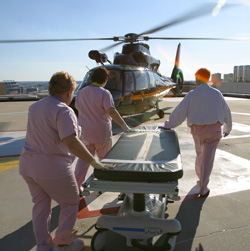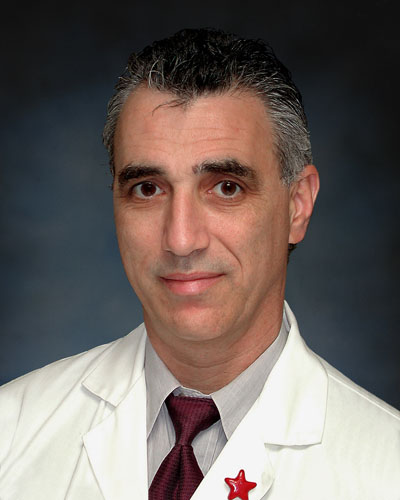Program in Trauma
Saving Lives, Advancing Science and Educating Future Leaders in Trauma Care
Injury is the leading cause of death in Americans under the age of 45 and the fourth leading cause of death in Americans over the age of 65. Estimates are that by the year 2020, road traffic collisions will be the second leading cause of death worldwide. Despite the magnitude of the public health problem that injury represents, it has not received the recognition that it deserves.
Injury is a disease. No matter what the cause of the injury, the relationships that govern blood loss and tissue crush injuries are complex. Many of them are still poorly understood. Caring for injury is the quintessential example of multidisciplinary medical care. Every discipline plays a role in caring for acutely injured patients. Every basic science effort has projects that can be directly referable to injury investigation and/or care.
Clinical care at a trauma center must be streamlined, focused and precise, as patients usually have life-threatening injuries. Multiple casualties at the same time are the norm, not the exception. The trauma team must be able to spring into action at a moment's notice and must be able to expand and contract resources to meet the needs. The environment can be highly charged and extremely hectic. Nurses, technical support personnel and physicians from a multiplicity of disciplines must be able to evaluate and treat simultaneously.
The trauma surgeon must be able to choreograph a sometimes seemingly chaotic ballet in order to insure optimal outcome. Despite the intense pressure, loss of composure may mean loss of life. The trauma surgeon must be able to perform complex surgical procedures in all areas of the body. Subspecialty consultation almost always would take too long. In addition, the trauma surgeon must be a primary care physician and an intensivist at the same time. He or she must be able to deliver bad news to a family and yet not lose focus, as another patient may arrive in the next few minutes. It takes a special set of skills to be able to do this work.

The Program in Trauma at the University of Maryland School of Medicine is the only multidisciplinary dedicated physician group practice that cares for injury in the United States. Almost the entirety of clinical practice is at the R Adams Cowley Shock Trauma Center, regarded as one of the international standard-setters for the care of injury. The Shock Trauma Center sits at the top of the most sophisticated pre-hospital system in the country. Founded by the late R Adams Cowley, the Shock Trauma Center and the Maryland Institute for Emergency Medical Services Systems co-exist to provide sophisticated expert medical care.
Clearly, the goals of the program go well beyond that of patient care. Education and research sit at the cornerstone of the Program in Trauma's mission. Our goal is to save lives, advance science and educate all types of healthcare professionals from many disciplines. I am proud to be part of the Shock Trauma Center, the Program in Trauma and the University of Maryland School of Medicine.

